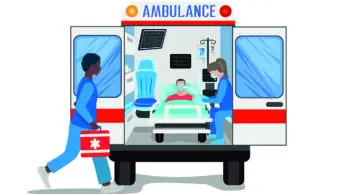“Me and my sister would drive huge distances late at night, completely exhausted, trying to find a chemist that could dispense the drugs. Nobody came out to deliver them or administer them or call in to the house or coordinate anything,” says Kate*, describing her experience of trying to access palliative care medicines for her father during his end-of-life care.
In a report from the charity Marie Curie, ‘Better end of life 2024: Time to care in England’, published in September 2024, Kate explains that the lack of support and coordination from palliative care services made looking after her father at home challenging1.
“It was just so chaotic. If it was a weekend, there were never enough staff there, just the on-call people. We had to do the running around ourselves.
“I was struggling managing work and running to and from the hospital. Between me and my sister, one of us would always be there helping out,” she says.
“I honestly don’t know to this day whether there were things my dad could have had to make the whole process easier on him and easier on us, because nobody really ever came to the house.”
Marie Curie estimates that, if the proportion of people requiring palliative care remains the same, the number of people with palliative care needs in the UK would increase by more than 147,000 between 2023 and 2048 — a rise of 25%. This would mean that, by 2048, more than 730,000 people will die annually with palliative care needs; however, the charity says this is likely an underestimate because it does not account for demographic changes, including people dying at older ages with complex conditions2 (see Box 1).
Box 1: Accessing palliative care
Palliative care is specialised medical care designed to improve the quality of life of people with serious illness and provide support to them and their families3,4. It is achieved through prevention and relief of suffering from pain and other symptoms, managing side effects from treatments and psychosocial care. Palliative care can be provided at any stage of illness. It includes end-of life-care, which is usually for people who are in the last year of life5.
Four steps are needed for patients to access palliative care medicines: someone to assess and advise on what medicines are needed; someone to prescribe the medicines; someone to dispense the medicines; and someone to administer them at speed.
“It’s an enormous challenge, especially at nights and weekends,” says Ruth Driscoll, associate director of policy and public affairs for England at Marie Curie.
“It’s a wicked problem,” says Ben Bowers, a clinical academic community nurse with the University of Cambridge and Queen’s Nursing Institute, who specialises in palliative and end-of-life care. “It’s one of those problems that is multifaceted and it’s really difficult to solve.”
“More people are dying at home… [and] we’ve got an overarching trend on the number of expected home deaths, which is going up and will continue to go up. So, we need to find viable solutions at scale,” he says.
Community access
According to Marie Curie’s ‘Better end of life 2024’ report, most end-of-life care occurs in the community, with 64% of people spending most of the last three months of their life in a private home, 24% in a care home and only 7% in hospital1.
But Ruth Driscoll, associate director of policy and public affairs for England at Marie Curie, says access to critical medicines in the community is a “massive issue”.
In 2022, responses from a Marie Curie survey of NHS staff in 60 areas, covering around half of the UK, revealed that only 25% of areas surveyed had a pharmacy open throughout the night to dispense palliative care medicines, while 55% had a pharmacy open for some of the night6.
People are having to call an ambulance or come into A&E because they’re reaching a crisis
Ruth Driscoll, associate director of policy and public affairs for England at Marie Curie
The survey also found that only 30% of areas had healthcare professionals who could administer these medicines throughout the night, with 68% having availability during some of the night6.
“As a result [of not getting their medicines on time], people are having to call an ambulance or come into A&E because they’re reaching a crisis, which are, what we feel, avoidable hospital admissions,” explains Driscoll.
She points out that access is even more challenging in the most deprived and most rural areas of the country, owing to reduced numbers of out-of-hour services and increased travel distances.
Cutbacks to community pharmacy opening hours are also making it difficult to access palliative care medicines in some areas. An analysis of NHS Business Services Authority data by The Pharmaceutical Journal found that the number of community pharmacies open for 100 hours a week or more in England has dropped dramatically from 942 pharmacies in December 2022 to just 86 pharmacies as of September 2024.
“We often hear about families contacting or going around various pharmacies trying to get medicines. So, even after you’ve got a prescription, physically getting the medications filled can be a huge burden for families,” says Sarah Cox, palliative care consultant lead at Chelsea and Westminster Hospital and president of the Association for Palliative Medicine of Great Britain and Ireland.
“It’s also very difficult for community pharmacies because keeping these drugs can be expensive.
“And when these drugs expire, which they frequently do before they are dispensed, you lose more money than you get from the commissioned income. So, it’s a service that pharmacists are doing as a goodwill gesture,” she states.
National pharmacy scheme
To make access to these medicines more consistent across England, the Pharmacy Quality Scheme (PQS) 2023/2024, published by NHS England in June 2023, outlined that community pharmacies must routinely hold 16 palliative care and end-of-life critical medicines by 31 March 2024 in order to claim a share of the £45m funding available7 (see Box 2). Contractors who were not stockholders of these critical medicines could still claim payment under the scheme if they could support access to these medicines by completing an action plan.
Box 2: Palliative and end-of-life critical medicines listed in the Pharmacy Quality Scheme
The Pharmacy Quality Scheme (PQS) is a voluntary payment scheme, launched in 2016, that rewards community pharmacies in England for meeting quality standards in three areas — clinical effectiveness, patient safety and patient experience8.
The palliative and end-of-life care (PEoLC) domain of the PQS was first introduced in 2022/2023 to address the “unwarranted variation of care” within palliative services9.
Under the 2023/2024 scheme, pharmacies that want to claim funds through the PEoLC domain are required to routinely stock 16 critical medicines. These include:
- Cyclizine solution for injection ampoules 50mg/1mL;
- Cyclizine tablets 50mg;
- Dexamethasone solution for injection ampoules 3.3mg/1mL;
- Dexamethasone tablets 2mg;
- Haloperidol tablets 500mcg;
- Hyoscine butylbromide solution for injection 20mg/1mL;
- Levomepromazine solution for injection ampoules 25mg/1mL;
- Metoclopramide solution for injection ampoules 10mg/2mL;
- Midazolam solution for injection ampoules 10mg/2mL;
- Morphine sulfate oral solution 10mg/5mL;
- Morphine sulfate solution for injection ampoules 10mg/1mL;
- Morphine sulfate solution for injection ampoules 30mg/1mL;
- Oxycodone solution for injection ampoules 10mg/1mL;
- Oxycodone oral solution sugar free 5mg/5mL;
- Sodium chloride 0.9% solution for injection ampoules 10mL;
- Water for injections 10mL.
Contractors must also support local access to parenteral haloperidol7.
The PQS is not currently active since it is part of the 2024/2025 ‘Community pharmacy contractual framework’, for which negotiations have not restarted following the change in government. It is not yet known whether there will be a PQS in 2024/2025.
Despite the national incentive, data gathered through a freedom of information (FOI) request sent by The Pharmaceutical Journal to NHS England revealed that only 47% of pharmacies in England routinely stocked the 16 critical medicines by the March 2024 deadline.
There was wide variation in the proportion of pharmacies participating across the 42 integrated care boards (ICBs), ranging from 31% in Bedfordshire, Luton and Milton Keynes (BLMK) ICB to 76% in Norfolk and Waveney ICB. According to data collected on the PQS 2023/2024 by the NHS Business Services Authority (NHS BSA), 54 pharmacies had no action plan to signpost patients (see Figure 1).
“The palliative care domain was introduced into the PQS to try to encourage consistency across the country, and so healthcare professionals could go on to the NHS service finder and see whether pharmacies have those 16 medicines in stock and direct patients to pharmacies,” explains Rosie Taylor, head of service development at Community Pharmacy England (CPE).
However, Taylor says that, while most pharmacies in England did not meet the palliative care domain of the PQS in 2023/2024, the number of pharmacies that provide access to palliative care medicines through locally commissioned services is likely to be much higher.
“The 47% of pharmacies who ticked the box in PQS would mean they need to have held all 16 medicines, so it might be that they held 15 as part of their local scheme, but they didn’t quite meet the criteria,” she explains.
According to CPE’s local service database, as of 2 December 2024, there are 114 locally commissioned palliative care services listed, many of which were launched before palliative care was included in the PQS10 (see Figure 1).
“Looking at our database, there are lots of services commissioned locally and there is good coverage across the country,” says Taylor, adding that the local schemes are “really important for helping access to palliative care medicines”.
Local services
BLMK ICB, where only one-third of pharmacies meet the PQS palliative care domain, has had a local service in place for more than 20 years. Fiona Garnett, the ICB’s associate director of pharmacy and medicines optimisation, has concerns about the PQS.
“One, it’s a scheme for 2023/2024 and there is no scheme yet for 2024/2025, so there is no obligation for pharmacies to continue as they are not being paid for it,” says Garnett.
“We also have a concern over the medicines list, because it doesn’t contain glycopyrronium, a drug we use for excessive respiratory secretions. We felt that was an omission.”
Garnett also highlights the environmental impact of stocking and dispensing medicines such as oxycodone injections that are not used within the ICB, which could go out of date and add to medicines waste.
Instead of the national scheme, Garnett refers to BLMK ICB’s locally-commissioned ‘End-of-life care medicines service‘.
We decided we were going to maintain a local service, even though it’s a cost pressure for the integrated care board
Fiona Garnett, associate director of pharmacy and medicines optimisation, Bedfordshire, Luton and Milton Keynes Integrated Care Board
“We decided we were going to maintain a local service, even though it’s a cost pressure for the ICB. This has been in place for several years and was developed with prescribing clinicians and pharmacies,” says Garnett.
“The local service is very similar to the PQS, only we have a specific number of pharmacies that are geographically located across BLMK. They get a retainer fee and we pay for any medicines that go out of date.
“In 2023/2024, what we have found is that, by concentrating supply to high-volume pharmacies that have high turnover and a restricted list of drugs that match what we actually use, we can meet the needs of clinicians, patients and families, and we have very low wastage,” she states.
Garnett’s concerns around the national PQS are echoed by several other ICBs in the country. Black Country, North East London, and Frimley ICBs, which had among the lowest uptake of the national scheme, have all informed The Pharmaceutical Journal that they have implemented a locally commissioned service, better tailored to their region.
However, while recognising the value of local services in terms of flexibility to tailor offerings to local needs, Cox believes that “unless we have some sort of national minimum ask, it’s very difficult to hold ICBs to account for what’s being provided”.
Anticipatory prescribing
One way of overcoming the difficulties with accessing palliative care medicines, particularly out of hours, is to prescribe ‘anticipatory medicines’. In March 2017, the National Institute for Health and Care Excellence (NICE) published the ‘Care of dying adults in the last days of life’ guidance, which encouraged service providers and healthcare professionals to prescribe anticipatory medicines to enable rapid relief at whatever time a patient developed distressing symptoms11.
In the UK, standard anticipatory prescribing, also known as ‘just in case’ prescribing, mainly involves four injectable medicines to treat symptoms of pain, nausea and vomiting, agitation, and noisy respiratory tract secretions12.
These medicines, along with equipment and signed administration authorisation charts, are kept in patients’ homes or care homes, where they are made available for visiting nurses, doctors, paramedics or trained family carers13.
The whole practice of anticipatory prescribing of end-of-life injections is quite common now
Tarun Nayyar, senior clinical pharmacist, Birmingham Hospice
“The whole practice of anticipatory prescribing of end-of-life injections is quite common now,” says Tarun Nayyar, senior clinical pharmacist at Birmingham Hospice.
“So, rather than managing a complete end-of-life situation on a Saturday afternoon or evening, where patients have no morphine at home, and then having to find someone to prescribe the drug, get the prescription and dispense, we try avoiding all that by pre-emptively doing a lot of this work in the earlier weeks.”
Nayyar explains that nurse and pharmacist prescribers regularly visit hospice patients at home and can prescribe palliative care medicines if needed, although he points out that most patients receiving end-of-life care are managed by GPs, rather than a hospice.
While anticipatory prescribing is a well-established intervention in palliative care, a systematic review, published in April 2023 in the BMJ, found that there is inadequate evidence on the clinical and cost-effectiveness of these prescriptions12. It is also estimated that between 40% and 54% of anticipatory prescriptions go unused13.
The systematic review, led by Bowers, concluded that evidence is primarily based on professional perceptions that the intervention provides effective, timely symptom relief in the community and prevents crisis hospital admissions. It added that more data on the effectiveness and safety of anticipatory prescribing are needed12.
Clinicians have also raised safety concerns around the potential for misuse of anticipatory medicines, risk of medicines being diverted to someone else, as well waste issues if they are overprescribed.
Despite concerns, Bowers says there is a consensus that anticipatory prescribing is a “good thing” and the focus should be on timely prescribing of anticipatory medicines, educating patients and their families on their medicines, and supporting independent prescribers by ensuring access to electronic patient records.
A national integrated plan
While community pharmacies, ICBs and charities continue to work on addressing access to critical end-of-life medicines through highlighting the challenges and providing local services, Bowers says a more holistic approach is needed to improve overall access to palliative care.
We need to respond as an integrated system and not in silos, so we can best meet a person’s palliative care needs
Ben Bowers, a clinical academic community nurse with the University of Cambridge and Queen’s Nursing Institute
“In an ideal world, we’ll have more GPs, more pharmacists, and more nurses, but we’re in a resource-constrained environment.”
He highlights some schemes around the country that have single phone numbers that patients or their families can call to access all palliative care services.
“That’s quite an effective scheme,” he says. “[For example], if there is limited capacity for district nurses to see a patient urgently, seeing if there is capacity from paramedics, hospice services or GP surgeries, who could be there. That one number could also provide [information on] which pharmacies have got supply [of end-of-life medicines].
“We need to respond as an integrated system and not in silos, so we can best meet a person’s palliative care needs.”
While some areas are piloting a single point of access for palliative care services, Cox says that implementation at a national level would be “the dream”.
“I would love to see a national plan for palliative and end-of-life care, which included things such as: ‘An ICB must ensure that patients can receive timely administration of urgent medications within two hours at any time of the day and night’,” she says.
“Hopefully in the [new] NHS’s ten-year plan, that’s exactly the sort of thing that we can get to come out of this.”
*Surname not provided in the report.
- This article was amended on 10 January 2025 to clarify and provide more context to the PQS in Box 2 and Taylor’s comments in the ‘National pharmacy scheme’ section of the article
- 1.Marie Curie. Better End of Life 2024, Time to care in England. Marie Curie Better End of Life 2024 report. September 2024. Accessed January 2, 2024. https://www.mariecurie.org.uk/policy/better-end-life-report
- 2.Marie Curie. How many people need palliative care? . Marie Curie Data and evidence briefing . July 2023. Accessed January 2, 2025. https://www.mariecurie.org.uk/globalassets/media/documents/policy/policy-publications/2023/how-many-people-need-palliative-care.pdf
- 3.World Health Organisation. Palliative care. World Health Organisation. Accessed January 2, 2025. https://www.who.int/health-topics/palliative-care
- 4.Get Palliative Care. What is Palliative Care? Get Palliative Care. Accessed January 2, 2025. https://getpalliativecare.org/whatis/
- 5.Marie Curie. What is end of life care? Marie Curie. May 10, 2024. Accessed January 2, 2025. https://www.mariecurie.org.uk/help/support/terminal-illness/preparing/end-of-life-care#palliative-care
- 6.Marie Curie. Better End of Life 2022. Marie Curie Better End of Life 2022 report. November 2022. Accessed January 2, 2025. https://www.mariecurie.org.uk/globalassets/media/documents/policy/beol-reports-2022/better-end-of-life-report-2022.pdf
- 7.NHS England. Pharmacy Quality Scheme 2023/24 . NHS England. June 1, 2023. Accessed January 2, 2025. https://www.england.nhs.uk/wp-content/uploads/2021/09/PRN00176-pharmacy-quality-scheme-guidance-23-24-v2.pdf
- 8.NHS England. Pharmacy quality scheme. NHS England. Accessed January 2, 2025. https://www.england.nhs.uk/primary-care/pharmacy/pharmacy-quality-payments-scheme/
- 9.Community Pharmacy England. Pharmacy Quality Scheme 2022/23 former website content . Community Pharmacy England. April 2023. Accessed January 2, 2025. https://cpe.org.uk/wp-content/uploads/2023/04/Pharmacy-Quality-Scheme-2022-23-Archived-website-content.pdf
- 10.Community Pharmacy England. Local Services Database. Community Pharmacy England. December 2, 2024. Accessed January 2, 2024. https://cpe.org.uk/lpcs-and-local/locally-commissioned-services/local-services-database/
- 11.National Institute for Health and Care Excellence. Care of dying adults in the last days of life. National Institute for Health and Care Excellence. March 2, 2017. Accessed January 2, 2025. https://www.nice.org.uk/guidance/qs144
- 12.Bowers B, Antunes BCP, Etkind S, et al. Anticipatory prescribing in community end-of-life care: systematic review and narrative synthesis of the evidence since 2017. BMJ Support Palliat Care. 2023;13(e3):e612-e623. doi:10.1136/spcare-2022-004080
- 13.Bowers B, Howard P, Madden B, Pollock K, Barclay S. Is end-of-life anticipatory prescribing always enough? BMJ. Published online May 16, 2023:p1106. doi:10.1136/bmj.p1106
1 comment
You must be logged in to post a comment.




My dissertation for my Public Health Masters in 2003 was about the availability of access to palliative care drugs out of hours.
Interestingly some of the schemes I reviewed supplying controlled drugs were illegal.
Those areas which had a scheme with community pharmacists on a rota to supply found varying uptake. A key learning was that you have to continually remind people the scheme is there.